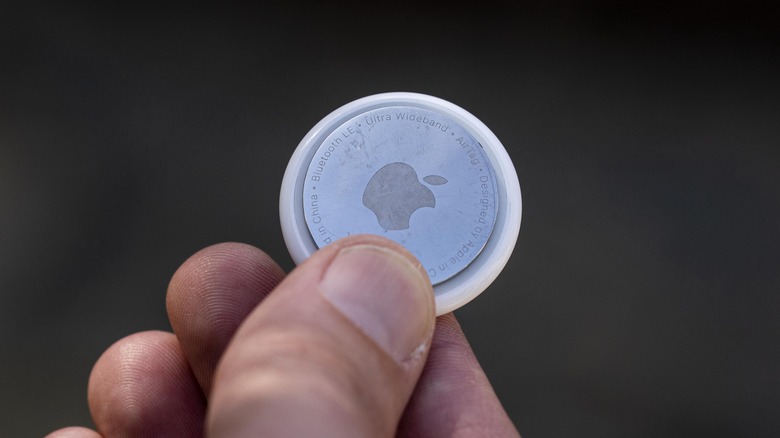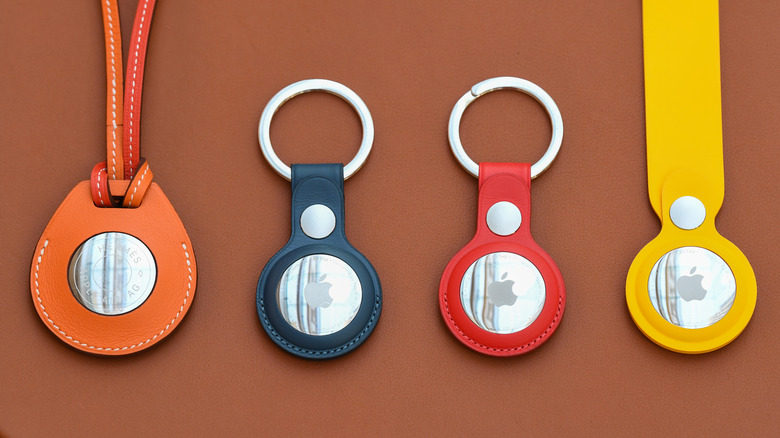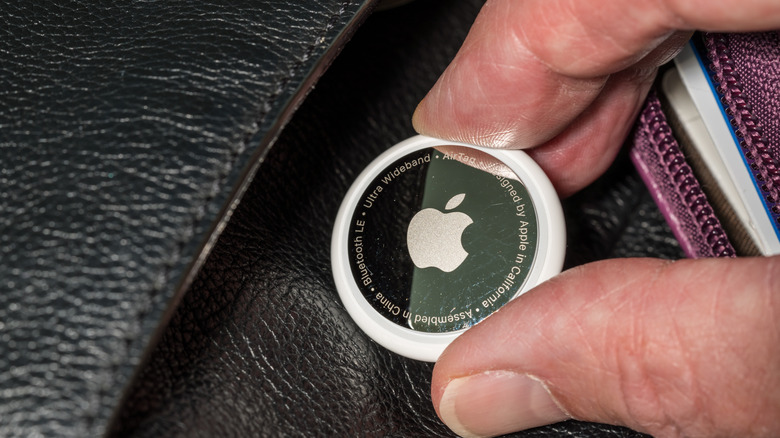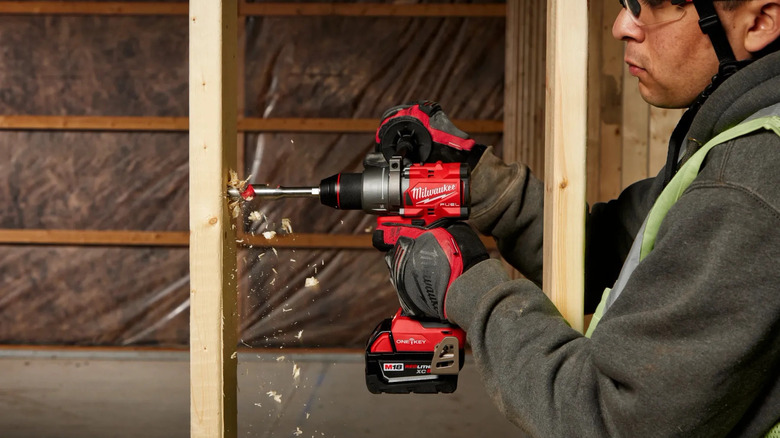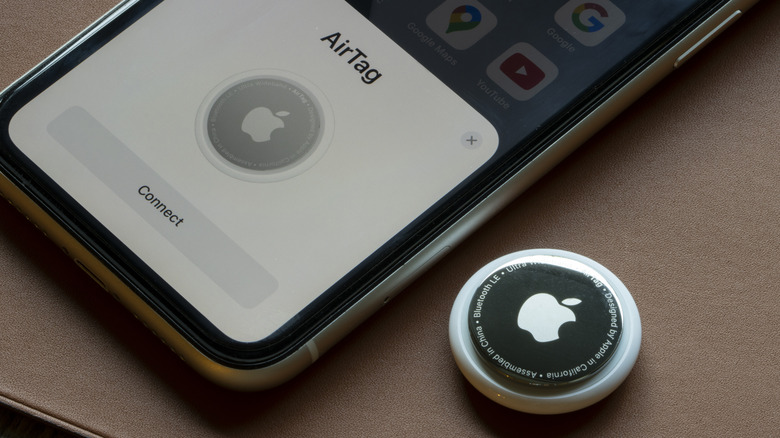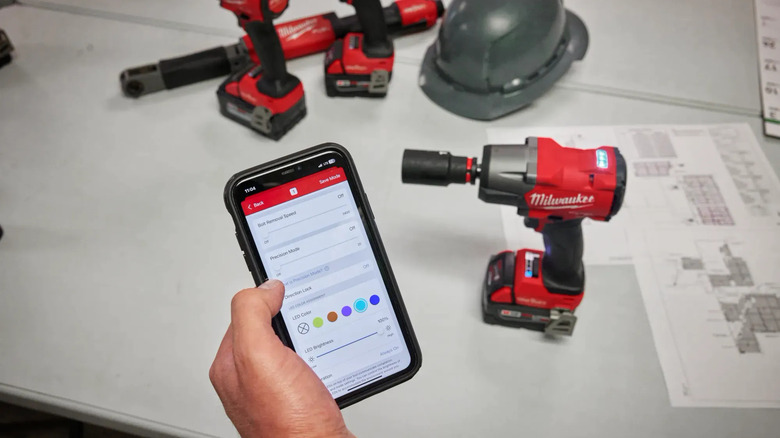Should You Use AirTags To Track Your Milwaukee Tools? 5 Things To Consider
Milwaukee power tools are valuable and, occasionally, expensive products. Needless to say, they're things you'd probably like to keep a close eye on if you can, both because they're valuable to you and because replacing them would be expensive. This goes double if the Milwaukee tools you're using are the property of your employer, renting tools out to employees for use on a jobsite. Either way, you need a good way to keep track of those tools.
When it comes to tracking things in today's world, one of the first options that may spring to mind is a Bluetooth tracking device, such as the Apple AirTag. In theory, an AirTag would be the perfect way to keep track of your Milwaukee tools. They're readily available and well-known for their tracking efficacy via the Apple Find My app. However, attaching an AirTag to a professional-grade Milwaukee power tool isn't quite the same as attaching one to a slippery set of keys. There are a few factors you might want to take some time to consider before you go out and buy a massive stack of AirTags.
Do you have a reliable way to attach an AirTag to tools?
The first, and perhaps most obvious question to consider with any AirTag scenario, including attaching one to a Milwaukee tool, is whether or not you actually have the ability to attach one. AirTags are designed to be attached to a variety of different objects and surfaces through the use of various accessories, including sticky pads and mounts, key rings, and wire cable holders. One of these approaches might work for some Milwaukee products, especially simple ones like battery packs, but definitely not all of them.
Let's say, for example, you're using one of Milwaukee's M18 impact wrenches. There isn't really anywhere on the tool you could hook a keyring or cable holder aside from maybe the belt hook if you aren't using it, and that's if you don't mind it jangling around while you're using the tool. As for a sticker mount, you would specifically need one just small enough to fit on the tool's surface, though it's anyone's guess how long the adhesive would last in the face of an impact wrench's heavy vibrational force.
Do you have a way to hide an AirTag?
While Milwaukee tools can be quite valuable, AirTags are no slouches in the pricing department either. A single one of those things costs around $30, and if a would-be thief could pry it loose from whatever you stuck it on, there's a good chance they'd just run off with the tag itself. This is why a lot of AirTag users prefer to hide their AirTags, either by placing them in an out-of-sight pocket on a bag or building some kind of special mount from scratch.
Making an AirTag mount for a Milwaukee tool that hides its presence to some degree is theoretically possible, but definitely not easy. Unless you happen to be a talented crafter with a good understanding of the AirTag's dimensions, not to mention the dimensions of whatever tool you're trying to stick it on, any mount you create is probably going to stick out like a sore thumb. Even if you can hide the large Apple logo from view, ne'er-do-wells might still be made curious by the large lump of plastic you've attached to your power drill.
Can an AirTag withstand what you'll be using the tool for?
AirTags, to their credit, are surprisingly resilient little gizmos. They have an IP67 water and dust resistance rating, and based on tests conducted by publications like CNET, they can handle an occasional spin in the washing machine or an accidental drop onto a hard surface from a few feet up. However, the kind of punishment that an AirTag may endure during common, everyday use is a very different beast from the kind of horrors it may endure on a professional job site.
Job sites are a microcosm of physical punishment and dirtiness, with both workers and the tools they use regularly subjected to constant drops, the scorching heat of the sun, occasional splashes of thick mud, and more. AirTags can only operate in a range of -4 to 140 degrees Fahrenheit; any further in either direction, and you'll have problems. That's not even mentioning the potential of sudden impacts and vibrational force that an AirTag may be subjected to while attached to a Milwaukee power tool. An AirTag may be able to withstand an occasional scratch, but there's not enough information on anything above that, so trying to use one on a jobsite would be a gamble.
AirTags can only be tracked individually by a single user
If you have exactly one Milwaukee tool you want to track that is owned exclusively by you, an AirTag might work. However, if you were looking to add tracking functionality to a variety of tools on behalf of your company or job site, then using AirTags might not be such a good idea. The reason for this is that AirTags, when activated, are tied exclusively to a single Apple ID. Only their original user can track their location via the Apple Find My app on a paired iPhone, Apple Watch, or Mac computer. Unless you're unusually comfortable with sharing your Apple ID credentials around with your coworkers, nobody else would be able to track the tags' location, which presents a security risk.
Even putting that aside, attaching an AirTag to a tool doesn't let you track the tool itself. You can only track the AirTag, and if the AirTag falls off, is stolen, or otherwise misplaced, you might be able to track it down, but the tool may be missing in action forever.
Milwaukee already has its own tracking system
One major reason that attaching AirTags to your Milwaukee tools might be a poor investment is that some Milwaukee tools already have a tracking system built in. Milwaukee has a proprietary tracking system called One-Key, which is operated via the Milwaukee smartphone app. Various high-grade Milwaukee tools, particularly those in the M18 and MX FUEL lines, will have a One-Key Bluetooth tracker embedded in their handles, allowing the app to catalog and track them. Granted, the One-Key tracking system isn't as comprehensive as the AirTags', as an AirTag is backed by Apple's device network, but if you're only looking for tools in a single, small jobsite, that's less of a problem.
Even if you're using lower-end Milwaukee tools that don't have One-Key trackers built in, Milwaukee also offers standalone One-Key trackers that can be attached to other tools and important objects. These tags have built-in holes for screws, rivets, or zip-ties to hold strong to their targets, not to mention a similarly impact-resistant body to an AirTag. These tags have a simpler, lower-profile design, which might make them a lower-priority target for theft than the well-known AirTag.
